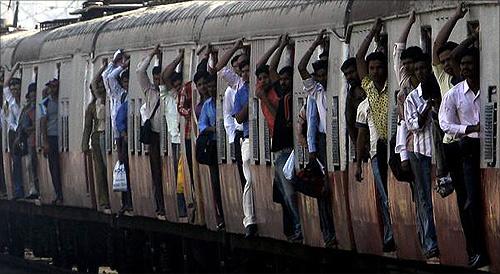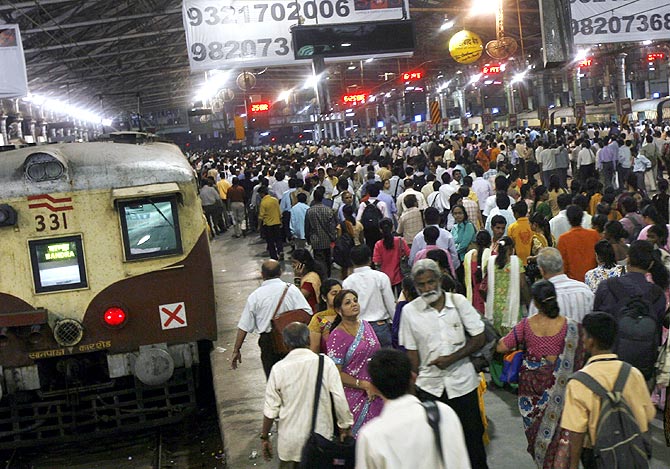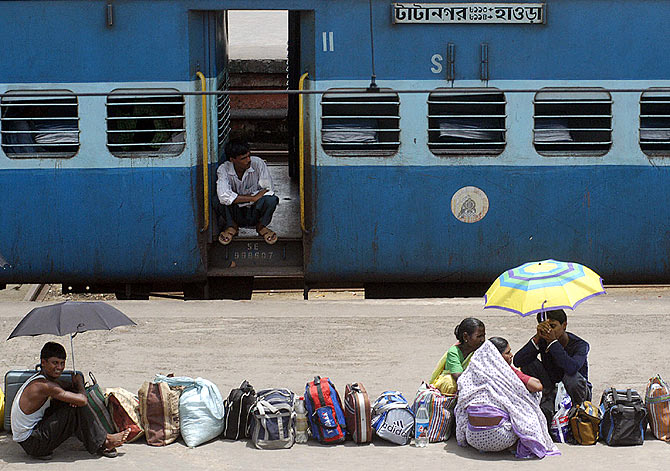Photographs: Courtesy, PIB Business Standard
Railway Board Chairman Arunendra Kumar says considering the current economic slowdown, an operating ratio of 90.8 per cent was encouraging.
In a media interaction, Kumar and Financial Commissioner (railways) Rajendra Kashyap talk about the railways’ achievements and the challenges ahead.
Edited excerpts:
Lower-than-estimated earnings and a higher operating ratio compared to last year -- how will you defend your financial performance this year?
Arunendra Kumar: Let me first say it is not bad financial performance; it’s pretty robust.
You will not find this kind of an operating ratio globally.
An operating ratio of about 90 per cent is not a bad show.
Given the constraints, I am satisfied with the performance this year.
We have just introduced the fuel-adjustment component; the fares have been only marginally increased after about 10 years.
With the containment of fares, we have gone for an increase in loading and higher passenger earnings to record this operating ratio.
Our financial commitment to key projects such as the Dedicated Freight Corridor remains strong.
For the whole project, the railways has to contribute about Rs 12,000 crore (Rs 120 billion), which we remain committed to.
. . .
'Railways' financial performance pretty robust'
Image: Passengers travel in a crowded suburban train at a railway station in Mumbai.Photographs: Arko Datta/Reuters
Were you able to meet your target of garnering Rs 6,000 crore (Rs 60 billion) through public-private partnerships in the Plan outlay for 2013-14?
Rajendra Kashyap: PPP is a very narrow term. The term we use is extra budgetary resources.
For extra budgetary resources, the major component continues to be the Indian Railway Finance Corporation.
But PPP comes from various sources.
The Rail Land Development Authority has given Rs 937 crore (Rs 9.37 billion).
Some lines are also constructed in association with state governments.
We loosely term it PPP.
Even for revised targets, we have kept it at Rs 6,000 crore (Rs 60 billion).
We might not achieve this number but we want to push ourselves and get the most we can. I am sure we will come close to it.
We might touch Rs 4,000-4,500 crore (Rs 40-45 billion) this year.
We are not merely raising this amount; it is also about the value of the infrastructure that will be created by the investment.
. . .
'Railways' financial performance pretty robust'
Image: People walk on platforms of Chhatrapati Shivaji Terminus railway station in Mumbai.Photographs: Arko Datta/Reuters
Was the ministry more interested in constituting a Rail Tariff Authority that was advisory in nature? Why is the railways shy of constituting a strong authority?
Kumar: If we were shy, we wouldn’t have recommended such an Authority.
We said if you want an Authority without legislation, it will be advisory.
The Cabinet said we don’t need advisory; we need an Authority that has command.
Then the issue of modifying the legislation came up.
But the question was how to start.
The concepts are very good -- we have said it is an advisory body, whose recommendations would ‘ordinarily’ be accepted.
But if these aren’t accepted, we have to give reasons why.
After the elections, the government can pass the amendment to constitute a regulatory body.
It will take about a year for the Authority to be operational.
The procedure will take time.
. . .
'Railways' financial performance pretty robust'
Image: Passengers queue up on the platform of the Howrah station.Photographs: Getty Images
With 100 per cent foreign direct investment expected in this segment, will you revise your PPP policy to meet the target and attract more investment?
Kumar: We are expecting FDI in ports, factories and other areas but not in train operations.
Once the Cabinet passes the foreign direct investment policy, we have to see its form.
We are dynamic in order to attract more investment.






article